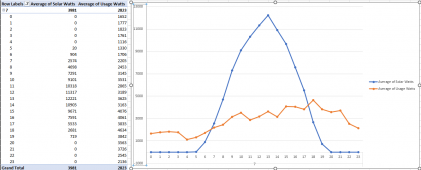FWIW, since I was looking for this info for a long time.
*Assuming no other tariffs for having solar, and assuming that consuming energy from the grid has distribution costs but sending it back does not.
My current bill with Ohio Edison indicates a Generation cost of $.657 KWh, a "Cost Recovery" of $.022KWh, and a Distribution cost of $.049KWh. Cost Recovery has remained the same, Distro has risen from $.0454 to $.0489 per KWh, Generation has varied from $.0601 down to $.0489 and now up to $.0657. Overall, over the last year, my bill runs around $.12/KWh to $.136.
As I have a Sense energy monitor I decided to use this and PVWatts to understand my bill if I went with solar. This again assumes Net Metering allows me to sell back at Generation rate, no distribution cost or cost recovery for selling back, and consuming (from the grid) has Generation cost, Distribution Cost, and Cost Recovery.
My findings.
Installing a 20KW system generates ~24,000KWh over the year (PVwatts). My consumption is 26,000KWh over the same period. My usage is higher in the winter and increases in the evenings and falls off around midnight.
Without solar the bills is estimated to be around $3,800 for the year.
With solar the bill would estimate out to $1,400.
Savings is just under $2400 per year.
*Bill by Month

This is solar production vs household consumption for July (highest production month)
*note, this is by HOUR of the day averaged across the month.

This is December (lowest production month.

In short, with a sell back rate that is just under half of my "buy" rate a solar system that covers over 95% of my usage will result in an average bill that is approximately 40% of what it would be without solar.
ROI on an hand built system should be 10 years, give or take (with rebate). I hate to think of the ROI on a purchased system...





